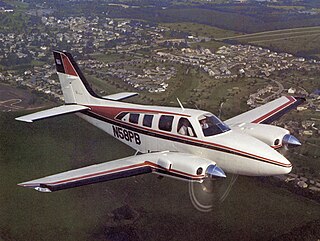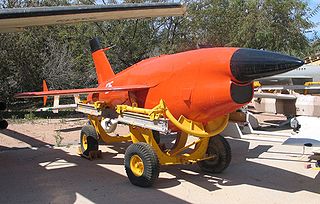| MQM-61 Cardinal | |
|---|---|
 | |
| Role | Target drone |
| National origin | United States |
| Manufacturer | Beechcraft |
The MQM-61 Cardinal was a target drone designed and built by Beechcraft.
| MQM-61 Cardinal | |
|---|---|
 | |
| Role | Target drone |
| National origin | United States |
| Manufacturer | Beechcraft |
The MQM-61 Cardinal was a target drone designed and built by Beechcraft.



While the Radioplane BTT was a popular piston-powered target, such a simple target was relatively easy to build and it developed competition. In 1955 Beechcraft designed the Model 1001, as the initial version of this target drone was designated, in response to a US Navy requirement for gunnery and air-to-air combat training. Production of the type began in 1959, with the drone being given the Navy designation of KDB-1, later MQM-39A. The Model 1001 led to the similar Model 1025 for the US Army, which gave it the MQM-61A designation. Beech also designed a variant powered by a turbojet engine and designated Model 1025-TJ, but nobody bought it. [1]
The MQM-61A was a simple monoplane with a vee tail. It was substantially larger than the MQM-36 Shelduck, and powered by a 94 kW (125 hp) McCulloch TC6150-J-2 flat-six, air-cooled, two-stroke piston engine driving a two-blade propeller. It could tow banners or targets of its own, with two targets under each wing, and also carried scoring devices. Launch was by RATO booster, recovery was by parachute. [2]
A total of 2,200 Cardinals of all variants were built, the majority for the US Army, with the rest operated by the US Navy, the US Marine Corps. [3]
General characteristics
Performance

The Beechcraft Baron is a light twin-engined piston aircraft designed and produced by Beechcraft. The aircraft was introduced in 1961. A low-wing monoplane developed from the Travel Air, it remains in production.

The Beechcraft T-34 Mentor is an American propeller-driven, single-engined, military trainer aircraft derived from the Beechcraft Model 35 Bonanza. The earlier versions of the T-34, dating from around the late 1940s to the 1950s, were piston-engined. These were eventually succeeded by the upgraded T-34C Turbo-Mentor, powered by a turboprop engine. The T-34 remains in service more than seven decades after it was first designed.

The Beechcraft Musketeer is a family of single-engined, low-wing, light aircraft that was produced by Beechcraft. The line includes the Model 19 Musketeer Sport, the Model 23 Musketeer, Custom and Sundowner, the Model 23-24 Musketeer Super III the retractable gear Model 24-R Sierra and the military CT-134 Musketeer.

The AQM-37 Jayhawk is an air-launched supersonic target drone manufactured by Beechcraft capable of simulating inbound ICBM warhead packages for fleet shoot-down exercises.

The Beechcraft Model 18 is a 6- to 11-seat, twin-engined, low-wing, tailwheel light aircraft manufactured by the Beech Aircraft Corporation of Wichita, Kansas. Continuously produced from 1937 to November 1969, over 9,000 were built, making it one of the world's most widely used light aircraft. Sold worldwide as a civilian executive, utility, cargo aircraft, and passenger airliner on tailwheels, nosewheels, skis, or floats, it was also used as a military aircraft.

The BQM-74 Chukar is a series of aerial target drones produced by Northrop. The Chukar has gone through three major revisions, including the initial MQM-74A Chukar I, the MQM-74C Chukar II, and the BQM-74C Chukar III. They are recoverable, remote controlled, subsonic aerial target, capable of speeds up to Mach 0.86 and altitudes from 30 to 40,000 ft.

The Beechcraft Queen Air is a twin-engined light aircraft produced by Beechcraft in numerous versions from 1960 to 1978. Based upon the Twin Bonanza, with which it shared key components such as wings, engines, and tail surfaces, it had a larger fuselage, and served as the basis for the highly successful King Air series of turboprop aircraft. Its primary uses have been as a private aircraft, utility, and small commuter airliner. Production ran for 17 years.

The Ryan Firebee is a series of target drones developed by the Ryan Aeronautical Company beginning in 1951. It was one of the first jet-propelled drones, and remains one of the most widely used target drones ever built.

The Radioplane BTT, known as RP-71 by the company, as WS-426/2 by the United States Navy, and as WS-462/2 by the US Air Force, is a family of target drones produced by the Radioplane Company.

The Culver Cadet is an American two-seat light monoplane aircraft, also as a radio-controlled drone, produced by the Culver Aircraft Company.

The Fairchild XNQ is an American trainer designed as a standard primary trainer for the United States Navy during the 1940s.

The McCulloch Model MC-4 was an American tandem-rotor helicopter and was the first helicopter developed by McCulloch Aircraft Corporation, a division of McCulloch Motors Corporation. It was evaluated by the United States Army as the YH-30 and the United States Navy as the XHUM-1.

The Microturbo TRI 60 is a small, expendable turbojet engine developed for use in cruise missiles, target drones, and other small unmanned air vehicles. Variants of this engine produce from 3.5 - 5.3 kN of thrust. The engine first ran in 1974.

The Beechcraft MQM-107 Streaker is a reusable, turbojet powered, target towing drone primarily used by the United States Army and the United States Air Force for testing and training. The US Army uses the drone for testing various surface-to-air missile systems such as the FIM-92 Stinger and the MIM-104 Patriot. The US Air Force uses them in practice engagements for their air-to-air missiles like the AIM-9 Sidewinder and the AIM-120 AMRAAM.

The MQM-42 was a supersonic target drone developed by North American Aviation. Developed in two subvariants, Redhead and Roadrunner, it was used by the United States Army in the 1960s and 1970s.

The HESA Karrar is an Iranian jet-powered target drone manufactured by Iran Aircraft Manufacturing Industrial Company (HESA) since 2010. The Karrar is a derivative of the American 1970s-era Beechcraft MQM-107 Streaker target drone, probably incorporating elements from the South African Skua, with hardpoints added for munitions. The Karrar was developed during the Ahmadinejad presidency.

The Globe KD6G Firefly is an American target drone, built by the Globe Aircraft Corporation for operation by the United States Navy during the 1950s and early 1960s.

The Republic SD-3 Snooper was an early reconnaissance drone developed by Republic Aviation for the United States Army. It was evaluated by the Army Signal Corps in 1959, but did not enter operational service.
The Radioplane OQ-6 was a target drone developed by the Radioplane Company under the designation RP-14 and evaluated by the United States Army Air Forces for service use. A small number were procured, but major production contracts were cancelled by the end of World War II.